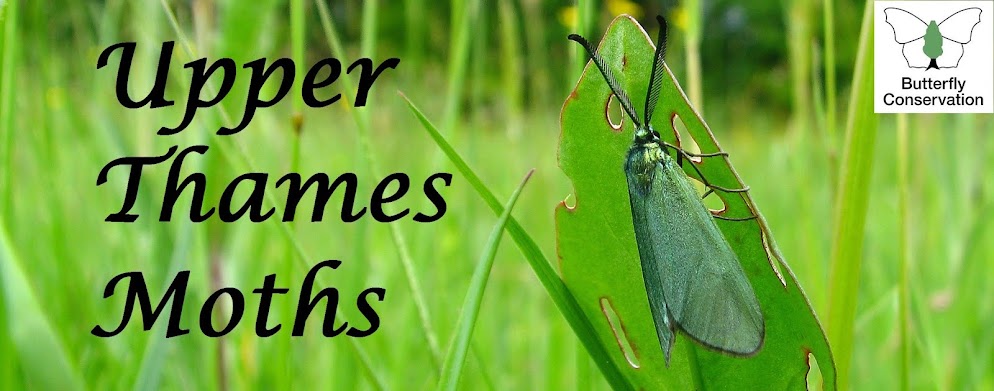(1st) Leucoptera laburnella*, Argyresthia brockeella, Ypsolopha dentella, Cedestis subfasciella, Oegoconia deauratella*, Metzneria lappella, Agapeta zoegana, Gypsonoma oppressana, Catoptria pinella, Anania crocealis, Phycitodes binaevella*, Wormwood Pug.
(2nd) Metzneria metzneriella, Garden Tiger, Double Lobed.
(3rd) Anarsia innoxiella, Parachronistis albiceps, Aethes rubigana, Celypha rosaceana*, Zeiraphera isertana, Eudemis profundana, Catoptria falsella, Shaded Broad-bar, Shaded Pug, Lesser Broad-bordered Yellow Underwing.
(4th) Eucosma campoliliana, Epiblema foenella, Rhyacionia pinicolana, Pammene regiana*, Gypsonoma minutana, Agriphila tristella, Schoenobius gigantella, Homoeosoma sinuella, Pyralis farinalis, Small Blood-vein, Slender Pug, Sycamore, Dusky Sallow, Fen Wainscot, Dark Spectacle.
(5th) Epinotia abbreviana, Pammene fasciana, Euzophera pinguis, Muslin Footman, Red-necked Footman.
The moths marked * are awaiting dissection to confirm. Those five nights produced a magnificent five completely new species for the garden, comprising Cedestis subfasciella, Anarsia innoxiella, Celypha rosaceana (if confirmed), Schoenobius gigantella and Fen Wainscot. Anarsia innoxiella is a recently-named species and it is understood that most previous British records of Anarsia lineatella (the Peach Twig Borer) will in fact be innoxiella. I've found it at one or two sites in Bucks this year so it is good that it should also turn up in the garden here. It will be very interesting to have Celypha rosaceana confirmed. The moth which appeared here was closest in colour to Aphelia paleana but was definitely the shape of an Olethreutinid rather than a Tortricinid. C.rosaceana can apparently lose its pink hue with age, turning more of a buff colour, and there are images on-line which look very similar to my specimen so I'm hoping that's what it will turn out to be. Fen Wainscot is not a common moth in Bucks but it was recorded very close to home by someone else last year and I've seen it a couple of times not too far away, so I was always hopeful that it would turn up in the garden. Although at first glance it could perhaps be dismissed as a Common Wainscot, it is actually noticeably "different" with a very silky appearance (not really apparent in the rather dull photo below) and obvious darker fringes to the forewings.
 |
| Anarsia innoxiella, Westcott 3rd July |
 |
| Probable Celypha rosaceana, Westcott 3rd July |
 |
| Fen Wainscot, Westcott 4th July |
Last night's Red-necked Footman was only the second recorded here, the first having been in 2013. After an initial burst of records locally at the beginning of this decade the species seems to have reduced in numbers again and hasn't yet become anywhere near as common as the other Footman species. I had Lappet again on the 3rd and 4th, Kent Black Arches arrived once more on the 4th while Garden Tiger has subsequently appeared on the 4th and the 5th. Finding this once very common moth on an egg-tray is always a welcome sight these days!
 |
| Garden Tiger, Westcott 2nd July |
The last two nights have been noteworthy for a plague of carabid beetles which have made a bit of a mess of any moths on the lowest egg trays or at the very bottom of the trap. There were getting on for 1,000 of them on the 4th but thankfully only a couple of hundred last night. Fewer than half of the initial invasion are visible in the quick phone-camera shot below but I should add that each corner has them piled up several layers deep as they tried to escape once the last egg-trays had been lifted out!
 |
| Invasion of carabids, Westcott 4th July |
Dave Wilton
Westcott, Bucks

Hi Dave, your photo of Anarsia innoxiella is very timely, as I've had a couple of these, one last night and one a couple of nights ago. I've been struggling to work out what they were until I saw your post!
ReplyDeleteDo I need to keep specimens of these for confirmation?
Hi Neil, there was a paper fairly recently detailing the separation from lineatella (see https://nl.pensoft.net/article/11184/). I've kept examples from the garden and one or two other sites for Peter to check but I think innoxiella can be ID'd safely using, amongst other things, the more obvious black stripe in the centre of the forewing.
ReplyDeleteThanks Dave, have kept them. Interesting to see that the species are already in MapMate.
ReplyDelete